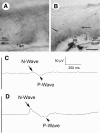Pathophysiology of neuropathic pain in type 2 diabetes: skin denervation and contact heat-evoked potentials
- PMID: 20841612
- PMCID: PMC2992207
- DOI: 10.2337/dc10-1135
Pathophysiology of neuropathic pain in type 2 diabetes: skin denervation and contact heat-evoked potentials
Abstract
Objective: Neuropathic pain due to small-fiber sensory neuropathy in type 2 diabetes can be diagnosed by skin biopsy with quantification of intra-epidermal nerve fiber (IENF) density. There is, however, a lack of noninvasive physiological assessment. Contact heat-evoked potential (CHEP) is a newly developed approach to record cerebral responses of Aδ fiber-mediated thermonociceptive stimuli. We investigated the diagnostic role of CHEP.
Research design and methods: From 2006 to 2009, there were 32 type 2 diabetic patients (20 males and 12 females, aged 51.63 ± 10.93 years) with skin denervation and neuropathic pain. CHEPs were recorded with heat stimulations at the distal leg, where skin biopsy was performed.
Results: CHEP amplitude was reduced in patients compared with age- and sex-matched control subjects (14.8 ± 15.6 vs. 33.7 ± 10.1 μV, P < 0.001). Abnormal CHEP patterns (reduced amplitude or prolonged latency) were noted in 81.3% of these patients. The CHEP amplitude was the most significant parameter correlated with IENF density (P = 0.003) and pain perception to contact heat stimuli (P = 0.019) on multiple linear regression models. An excitability index was derived by calculating the ratio of the CHEP amplitude over the IENF density. This excitability index was higher in diabetic patients than in control subjects (P = 0.023), indicating enhanced brain activities in neuropathic pain. Among different neuropathic pain symptoms, the subgroup with evoked pain had higher CHEP amplitudes than the subgroup without evoked pain (P = 0.011).
Conclusions: CHEP offers a noninvasive approach to evaluate the degeneration of thermonociceptive nerves in diabetic neuropathy by providing physiological correlates of skin denervation and neuropathic pain.
Figures

References
-
- Davies M, Brophy S, Williams R, Taylor A: The prevalence, severity, and impact of painful diabetic peripheral neuropathy in type 2 diabetes. Diabetes Care 2006;29:1518–1522 - PubMed
-
- Zaslansky R, Yarnitsky D: Clinical applications of quantitative sensory testing (QST). J Neurol Sci 1998;153:215–238 - PubMed
-
- Dyck PJ, Zimmerman IR, Johnson DM, Gillen D, Hokanson JL, Karnes JL, Gruener G, O'Brien PC: A standard test of heat-pain responses using CASE IV. J Neurol Sci 1996;136:54–63 - PubMed
-
- McCarthy BG, Hsieh ST, Stocks A, Hauer P, Macko C, Cornblath DR, Griffin JW, McArthur JC: Cutaneous innervation in sensory neuropathies: evaluation by skin biopsy. Neurology 1995;45:1848–1855 - PubMed
-
- McArthur JC, Stocks EA, Hauer P, Cornblath DR, Griffin JW: Epidermal nerve fiber density: normative reference range and diagnostic efficiency. Arch Neurol 1998;55:1513–1520 - PubMed
Publication types
MeSH terms
LinkOut - more resources
Full Text Sources
Medical

